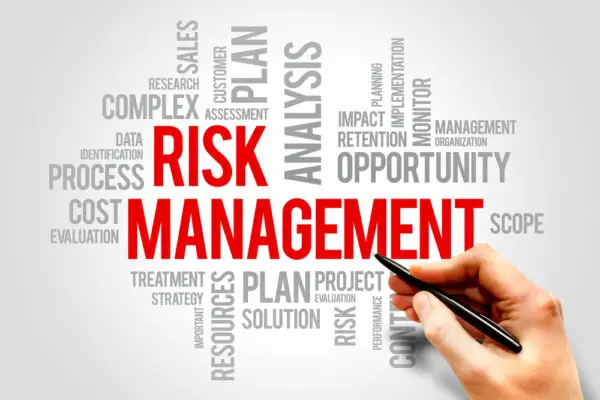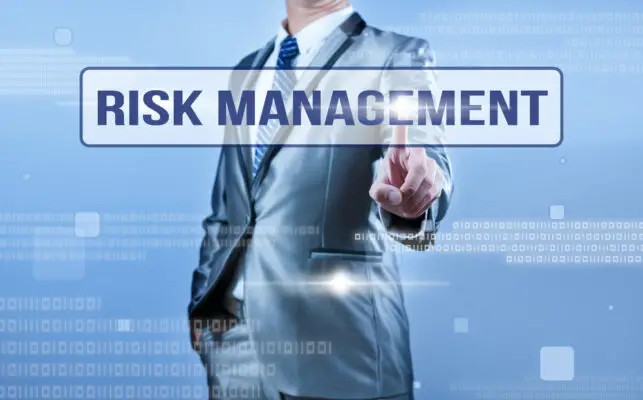ISO 31000:2018 defines risk management as “coordinated activities to direct and control an organization about risk.” This broad definition encapsulates various aspects of managing risk, including risk identification, analysis, evaluation, and treatment.
Risk management is a critical business function that involves identifying, assessing, and mitigating potential risks that may impact an organization’s operations, financial stability, reputation, and compliance with legal and regulatory requirements.
Risk management has become increasingly important for organizations of all sizes and industries in today’s rapidly changing business environment.
Effective risk management enables businesses to anticipate and manage risks proactively, minimize their impact on the organization, and make informed decisions that support long-term success. The following are some of the benefits of risk management to organizations.
Identifying Potential Risks: Risk management helps organizations identify risks in their operations, projects, and strategic initiatives. This proactive approach allows companies to anticipate problems and implement mitigation plans.
Minimizing Losses: Risk management helps organizations prevent or reduce financial losses by identifying potential threats and implementing mitigation strategies.
This can be particularly important in industries with common financial risks like finance, manufacturing, or construction.
Supporting Strategic Decision-Making: Risk management is about preventing or minimizing risks and making informed decisions. Management can make better strategic decisions by understanding the risks associated with different options.
Improving Operational Efficiency: By addressing potential risks proactively, organizations can avoid disruptions to their operations, thereby improving efficiency and productivity.
Protecting Reputation: In the era of social media and rapid information dissemination, a company’s reputation can be damaged quickly if risks are not managed effectively. Effective risk management can prevent or mitigate such scenarios.
Ensuring Compliance: Many industries operate under regulatory requirements that mandate certain risk management practices. Effective risk management ensures that these legal and regulatory requirements are met, helping to avoid fines, penalties, and damage to the organization’s reputation.
Increasing Stakeholder Trust: By demonstrating effective risk management, an organization can build trust with stakeholders, including investors, customers, and employees, reinforcing the perception that the organization is well managed.
The importance of risk management cannot be overstated, as it helps businesses navigate through uncertain times by providing them with a structured approach to identify potential threats and opportunities.
Through implementing effective risk management practices, companies can gain a competitive advantage by reducing their exposure to risks while maximizing their ability to take advantage of new market opportunities.
In this article, we will discuss in detail why risk management is important for businesses and how it can help organizations achieve sustainable growth by managing risks effectively.

Protects Business Operations and Financial Stability
To maintain the continuity of business operations and ensure long-term financial stability, organizations must implement effective measures that safeguard against potential threats and disruptions.
Risk mitigation strategies are essential in minimizing the impact of risks on a company’s assets, reputation, and profitability. Such strategies enable organizations to identify, assess, and prioritize risks by implementing processes that anticipate potential problems before they occur.
Business continuity planning is one such risk mitigation strategy that companies use to protect their operations from unforeseen events.
It involves developing procedures that outline how an organization will continue its critical functions during a disruption or disaster. A well-designed business continuity plan helps organizations respond quickly and effectively during a crisis, minimizing downtime while protecting employees and customers.
Effective risk management practices help businesses secure their financial stability by reducing the likelihood of major losses due to unexpected events. Companies can invest in insurance policies that cover losses due to various risks, such as natural disasters or cyber-attacks.
Organizations taking proactive steps towards identifying potential threats and addressing them early on through risk mitigation strategies like business continuity planning, companies can minimize losses and ensure their long-term financial viability without compromising their ability to operate efficiently at all times.
Maintains Reputation
Maintaining a favourable reputation is crucial for organizations to ensure the trust and loyalty of their stakeholders, as it can significantly impact their long-term success.
Reputation management involves actively monitoring and controlling the public perception of an organization to mitigate negative effects that could harm its brand image.
Effective reputation management practices include developing positive relationships with stakeholders, responding promptly and transparently to crises, and regularly communicating organizational values and successes.
One important aspect of reputation management is crisis communication. When an organization faces a crisis or negative event, it is essential to communicate effectively with stakeholders to minimize damage and maintain trust.
This involves providing timely updates, being transparent about the situation, taking responsibility for any organisational mistakes, and outlining steps to address the issue. Failure to do so can result in lasting reputational damage that may be difficult to repair.
Companies can maintain a positive reputation through effective risk management practices such as reputation management and crisis communication is essential for organizations looking to succeed in today’s competitive business environment.
It enables them to build customer trust, attract new investors, retain top talent, and ultimately achieve long-term success. By investing time and resources into these practices now, organizations can help prevent potential crises from turning into major setbacks.
Compliance with Legal and Regulatory Requirements
Compliance with legal and regulatory requirements is crucial for organizations to avoid potential legal consequences, maintain ethical standards, and promote social responsibility.
Legal compliance means that an organization must adhere to the laws and regulations set by government authorities, such as labour or environmental laws.
Regulatory compliance pertains to industry-specific rules or guidelines imposed by regulatory bodies. Non-compliance can result in significant fines, litigation costs, and reputational damage.
Risk assessment techniques are essential tools for organizations in identifying potential non-compliance risks. By conducting a risk assessment analysis, organizations can identify areas of vulnerability within their operations and take appropriate measures to mitigate such risks effectively.
Cost-benefit analysis is critical in evaluating the effectiveness of risk management strategies before implementation.
Effective risk management enables organizations to demonstrate their commitment to complying with legal and regulatory requirements while operating ethically and responsibly.
In today’s increasingly complex business environment, where rules governing various industries constantly change, it is vital for organizations to remain vigilant about compliance requirements continually.
Failure to comply could lead to financial losses and severe damage to an organization’s reputation that could be difficult or impossible to repair.
Organizations implementing robust compliance programs supported by effective risk management practices are key for any organization aiming for long-term success in this changing landscape.
Improves Decision Making
Effective risk management improves decision-making by using risk analysis to inform decisions and identify potential opportunities for growth and expansion.
Organizations can make informed decisions considering their actions’ consequences by analysing potential risks.
Additionally, identifying opportunities for growth and expansion through risk management allows organizations to capitalize on potential benefits while minimizing potential negative impacts.
Overall, effective risk management provides a structured approach to decision-making that maximizes positive outcomes while minimizing negative ones.
Use Risk Analysis to Make Informed Decisions
One may make uninformed and imprudent decisions by neglecting to assess potential hazards and their consequences, resulting in unfavourable and potentially catastrophic outcomes. Therefore, risk analysis is a crucial tool for decision-making in any organization.
Risk analysis helps organizations identify potential risks and uncertainties associated with a particular course of action, allowing them to weigh the costs and benefits of different options before deciding.
One key risk analysis component is uncertainty analysis, which involves identifying the degree of uncertainty associated with each risk factor. By quantifying this uncertainty, organizations can better understand the likelihood and severity of different outcomes and make more informed decisions accordingly.
Cost-benefit analysis is another important aspect of risk management; it allows organizations to estimate the costs of mitigating or avoiding certain risks relative to the benefits of these actions.
Through these methods, organizations can prioritize their resources towards areas where they can significantly reduce overall risk levels while maximizing gains from opportunities presented by uncertain events.
Identify Opportunities for Growth and Expansion
Identifying opportunities for growth and expansion is a crucial aspect of organizational strategy that enables businesses to capitalize on emerging trends, expand their customer base, and increase profitability.
Conducting market research is a fundamental step in identifying such opportunities as it helps organizations understand the needs and preferences of their target markets, evaluate the potential demand for new products or services, and identify gaps in the market that innovative solutions can fill.
By conducting thorough market research, businesses can gain insights into emerging trends, changing consumer behaviour patterns, and shifting preferences that can help them develop effective strategies to enter new markets or expand their existing offerings.
The competitive analysis also plays a vital role in identifying opportunities for growth and expansion as it helps organizations understand their position in the marketplace relative to their competitors.
This involves analyzing competitor strengths, weaknesses, market share, pricing strategies, marketing campaigns, and other factors that affect customer perceptions of competing brands.
By conducting competitive analysis regularly, businesses can make informed decisions about differentiating themselves from competitors through unique value propositions or by offering superior quality products at competitive prices.
Identifying opportunities for growth and expansion through market research and competitive analysis is essential for organizations seeking long-term success in today’s dynamic business environment.
Facilitates Long-Term Business Success
Ensuring the sustained success of a business requires implementing proactive measures that minimize potential disruptions and maximize growth opportunities. Risk management is essential to this process as it facilitates long-term business success by identifying, assessing, and mitigating potential risks.
Engaging in strategic planning, businesses can identify areas where they may face challenges or threats to their operations. This proactive approach enables companies to develop strategies that minimize the impact of these risks on their overall performance.
Moreover, risk management helps businesses maintain a competitive advantage by enabling them to take calculated risks. Companies willing to embrace change and explore new opportunities often reap significant rewards over time. However, this involves taking calculated risks backed by thorough research and analysis.
Risk management provides a framework for evaluating these risks and determining which ones are worth pursuing while minimising negative consequences.
Risk management plays a crucial role in facilitating long-term business success by enabling companies to identify potential threats and opportunities for growth before they arise.
Engaging in strategic planning helps organizations develop effective risk mitigation strategies while identifying areas where they can leverage their strengths to gain a competitive advantage.
Through a proactive approach to risk management, businesses can position themselves for sustained success in an ever-changing marketplace.

Frequently Asked Questions
What are the most common types of risks that businesses face?
Ironically, many businesses are willing to take risks to succeed yet fail to manage those risks properly.
Financial and operational risks are among the most common types of risks that businesses face. Financial risks include market volatility, credit default, liquidity issues, and fraud. Operational risks can arise from inadequate processes or systems, human error, or natural disasters.
Mitigation strategies such as insurance policies and diversification of investments can help minimize these risks. Prevention techniques like regular risk assessments and effective internal controls can also be crucial in avoiding potential losses.
How can risk management be integrated into a company’s overall strategy?
Risk assessment and mitigation planning are essential to a company’s overall strategy. By conducting thorough risk assessments, organizations can identify potential risks before they become problematic and develop strategies to mitigate them.
Effective risk management involves identifying potential threats and understanding their impact on the organization, including financial loss or reputational damage.
Developing a mitigation plan that addresses these risks can help protect against negative consequences and ensure business continuity in the face of unexpected events.
Integrating risk management into a company’s overall strategy is crucial for long-term success, as it allows businesses to proactively address potential issues and minimize their impact on operations.
What role do employees play in effective risk management?
Effective risk management in organizations depends on employees’ active participation and engagement. Employee engagement enables them to understand and take ownership of the risks associated with their roles, reducing the likelihood of unforeseen events.
Risk communication is crucial in promoting employee engagement by providing clear and concise information about potential risks and educating employees on mitigating them.
Employees aware of potential risks can also proactively identify new ones, leading to a more comprehensive risk management strategy.
Therefore, companies must prioritize employee engagement and effective risk communication as key components of their overall risk management strategy.
Can risk management help prevent unexpected crises or disasters?
Proactive risk management is critical for preventing unexpected crises and disasters. This highlights the importance of a proactive approach to identifying and assessing potential risks.
By implementing effective risk assessment strategies, organizations can anticipate potential threats and take preventive action to mitigate them before they become larger problems.
The benefits of proactive risk management include reduced financial losses, increased safety for employees and customers, improved reputation, and better overall organizational performance.
Therefore, organizations must adopt a proactive mindset towards risk management to safeguard against unpredictable events that could have catastrophic consequences.
How can a company measure the effectiveness of its risk management strategies?
To measure the effectiveness of its risk management strategies, a company can employ evaluation methods and compare its performance to industry benchmarks.
Evaluation methods may include assessing the frequency and severity of risks that have been identified and mitigated, monitoring key risk indicators, conducting stress tests or scenario analyses, and reviewing incident reports.
Industry benchmarks provide a useful comparison point for companies to assess the adequacy of their risk management strategies against those employed by peers in the same sector.

Conclusion
Risk management is crucial to any business, as it protects operations and financial stability. By identifying potential risks and implementing mitigation strategies, companies can safeguard themselves against unforeseen events that could cause significant harm.
Furthermore, effective risk management helps maintain reputation by demonstrating to stakeholders that the organization takes its responsibilities seriously.
Moreover, compliance with legal and regulatory requirements is integral to risk management. Failure to comply with these standards can result in severe consequences for businesses, including fines or legal action.
Proper risk management improves decision-making by providing a framework for evaluating potential risks and determining appropriate responses. This approach facilitates long-term business success by enabling companies to adapt quickly to changing circumstances while minimizing negative impacts on operations and financial health.
Effective risk management is essential for any business looking to maintain profitability and sustainability in today’s dynamic environment. By prioritizing this critical function, organizations can protect themselves from potential harm while positioning themselves for future growth opportunities.

Chris Ekai is a Risk Management expert with over 10 years of experience in the field. He has a Master’s(MSc) degree in Risk Management from University of Portsmouth and is a CPA and Finance professional. He currently works as a Content Manager at Risk Publishing, writing about Enterprise Risk Management, Business Continuity Management and Project Management.

